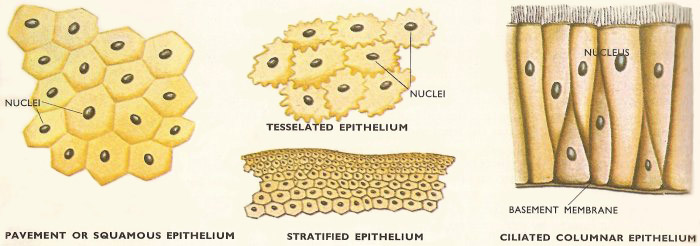epithelium

The epithelium is a layer or sheet of cells that lines a body cavity; they show an unusually high cell-turnover rate. Epithelial cells are held together by a small amount of cementing substance. The outer covering of the body (the skin), the lining of the gastrointestinal tract and other organs, such as the lungs and blood vessels, and the inner lining of the ducts in glands are examples.
Below most epithelia is a thin sheet of connective tissue, the basement membrane. The free surface of most types of epithelium (the surface that is not attached to other tissue) may have on it short hair-like structures called cilia.
When the epithelium is several layers of cells thick it is said to stratified.
The cells of epithelia may serve very different purposes. Those lining the salivary glands, and the glands in the intestine for example, produce the enzymes that digest food. The ones forming the outer covering of the skin are mainly protective and water-resistant, while the cells of the lung lining produce the wet mucus in which oxygen dissolves before passing to the blood.
Types of epithelium
An epithelium may be one or more cells thick and the cells may be of very different shapes and sizes. Some are thin and flat like crazy-paving stones. They form pavement or squamous epithelium which is found, for example, in the lining of parts of the kidney tubes. When the cells of squamous epithelium have wavy outlines (e.g., cells lining the blood vessels) they are said to be tessellated. Other cells are approximately as wide as they are tall. These form cuboidal or cubical epithelium which is found in many glands (e.g., the liver). In columnar epithelium the cells are tall and column-shaped. Such epithelium lines most of the gut.
If columnar cells bear cilia the epithelium is known as ciliated columnar epithelium. Ciliated cells occur in the lining of the trachea (windpipe). The cilia beat to help remove dirt particles.
The outer cells of the skin and the lining of the cheek form stratified squamous epithelium. It is also found in the front, transparent layer of the eye (cornea).


